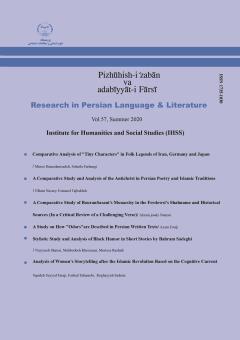A Study on How "Odors"are Descibed in Persian Written Texts
Subject Areas : پژوهشهای ادبیات کلاسیک ایران
1 - دانشيار گروه زبانشناسی، دانشگاه فردوسی مشهد
Keywords: Description of odors, Persian language corpus, Metaphor, Synesthesia.,
Abstract :
The present paper studies how odors are described in selected data from Persian written texts. For this purpose, instances of the use of the word "odor" and its dependents were extracted from two written corpus (including news and fiction texts, with about nine million words) and were classified and described based on structural and semantic features. Examination of the data shows that odors in Persian are described more with Ezafet constructions than descriptive constructions (82% vs. 18%). Regarding the method of describing odors, it was also found that Persian speakers prefer to describe odors with reference to their origin rather than using adjectives. In addition, it was found that in Ezafet constructions where odor is described with an noun, odor finds metaphorical usage and is used figuratively to mean "effect and sign". Regarding the adjectives used to describe odors, it was found that on the one hand there are limited adjectives to describe odors and on the other hand these adjectives can be semantically divided into three categories: pleasant adjectives, unpleasant adjectives and adjectives that emphasize odor specificity. In addition, the comparison of the two data sets showed that in the data extracted from news texts, the ratio of metaphorical use of smell was higher and in the data extracted from fictional texts, the ratio of describing smell by referring to its origin was higher, this difference can be explained by the nature of the texts being analyzed.
Chernigovskaya, Tatiana Vand Victor V. Arshavsky. Olfactory and visual processingand verbalization.Cross-cultural and neurosemiotic dimensions. In: Speaking of Colors and Odors. Editors: Martina Plümacher , Peter Holz [Converging Evidence in Language and Communication Research, 8] (2007) John Benjamins Publishing Company.
De Valk JM, Wnuk E, Huisman JLA, Majid A. Odor–color associations differ with verbal descriptors for odors: a comparison of three linguistically diverse groups. Psychon. Bull. Rev. (2017) 24.
Holz, P. Cognition, olfaction and linguistic creativity: Linguistic synesthesia as poetic device in cologne advertisementin: Speaking of Colors and Odors. Editors: Martina Plümacher , Peter Holz[Converging Evidence in Language and Communication Research, 8] (2007) John Benjamins Publishing Company. Huisman, J. L. A., & Majid, A. Psycholinguistic variables matter in odor naming. Memory & Cognition, (2018) 46(4), 577–588.
Majid, A.NiclasBurenhult.Odors are expressible in language, as long as you speak the right language.Cognition 130 (2014) 266–270.
Majid, A. NiclasBurenhult, Marcus Stensmyr, Josje de Valk, Bill S. Hansson.Olfactory language and abstraction across cultures. (2018a).373. Philosophical Transactions of the Royal Society B: Biological Sciences.
Majid, A. Seán G. Roberts, cLudyCilissen, aKarenEmmorey, dBrendaNicodemus, eLucindaO’Grady, dBencieWoll, fBarbaraLeLan, gHilário de Sousa, aBrian L. Cansler, hShakilaShayan, iConnie de Vos, a, bGunterSenft, aN. J. Enfield, jRogayah A. Razak, kSebastianFedden, lSylviaTufvesson, aMarkDingemanse, aOzgeOzturk, mPenelopeBrown, aClairHill, a, j, nOlivier Le Guen, oVincentHirtzel, pRik van Gijn, qMark A. Sicoli, r and Stephen C. Levinsona, b, 2Proc NatlAcadSci U S A.Differential coding of perception in the world’s languages. (2018b) Nov 6; 115(45): 11369–11376. Psychological and Cognitive Sciences.
Miller, G. What’s Up With That: Why Are Smells So Difficult to Describe in Words?
Available at: https://www.wired.com/2014/11/whats-up-with-that-smells-language/.
http://pldb.ihcs.ac.ir/VazheNama.
https://corpora.uni-leipzig.de/en?corpusId=fas_newscrawl_2011.


